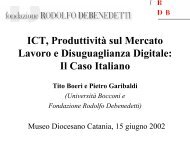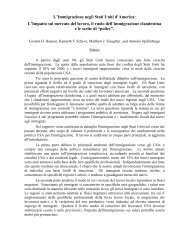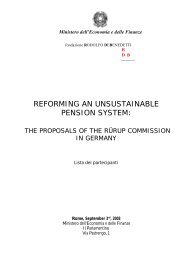The Executive Compensation Controversy - Fondazione Rodolfo ...
The Executive Compensation Controversy - Fondazione Rodolfo ...
The Executive Compensation Controversy - Fondazione Rodolfo ...
Create successful ePaper yourself
Turn your PDF publications into a flip-book with our unique Google optimized e-Paper software.
THE EXECUTIVE COMPENSATION CONTROVERSY: 24 MAY 2010A TRANSATLANTIC ANALYSISthought have emerged. <strong>The</strong> first is the “managerial power” view exemplified by Bebchuk,Fried and Walker (2002) and Bebchuk and Fried (2004a), in which powerful CEOs extracthigh levels of compensation from captive boards of directors. <strong>The</strong> second is the “efficientcontracting” view in which the increase in pay reflects changes in the managerial labormarket caused by changes in the distribution of company size (Gabaix and Landier (2008)) orthe increased prevalence of hiring CEOs from outside the firm rather than promoting fromwithin (Murphy and Zábojník (2007)). We will return to a discussion of the debate and asurvey of the related literature below in Section 2.4. But, as evident from Figure 2.3, anycompelling theory of trends in CEO compensation must address explicitly its most prominentfeatures: the escalation in stock options from the mid-1980s through 2001, and the emergingdominance of restricted stock.In the rest of this section, we will show how the trends in equity-based compensationcan be traced in large part to USA tax policies, accounting rules, and politics, having little ornothing to do with either managerial power or changes in the managerial labor market.2.4.1. <strong>The</strong> Rise (and Fall) of Restricted Stock Options (1950-1969)While a modest number of companies issued stock options during the 1930s and 1940s,America’s fascination with stock options began in earnest with the Revenue Act of 1950.Prior to the Act, the gains from exercising stock options were taxed as ordinary income to theindividual, and deductible as compensation expense to the company. <strong>The</strong> 1950 Act created anew type of options called “restricted stock options” that would be taxed as capital gains(rather than ordinary income) not upon exercise but only when the shares acquired throughexercises were ultimately sold. While these capital gains were not deductible by the firm as acompensation expense, the spread between the tax rate on ordinary income and capital gainswas sufficient to make the new options highly tax advantageous. In particular, in addition tocreating restricted stock options, the Revenue Act of 1950 increased the top marginal tax rateon ordinary income to 91% while increasing the top corporate tax rate to 50.75%. 33 Giventhese rates, it cost investors approximately €5.47 in after-tax profit to convey an incremental€1 in after-tax income to the CEO through cash salaries (or “non-qualified” stock options33 Under the Revenue Act of 1950, the top individual rate of 91% was triggered at income levels exceeding$200,000; the top marginal rate was 90% for income between $150,000 and $200,000 and 89% for incomebetween $100,000 and $150,000. Fryman and Saks (2008) estimate that the median corporate CEO earnedabout $150,000 in 1950, putting the median CEO at or near the top bracket. <strong>The</strong> top corporate rate of 50.75%was effective for corporations with over $25,000 in taxable income.-27-









